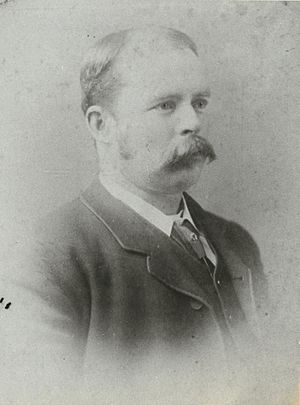Francis James Gillen facts for kids
Quick facts for kids
Francis James Gillen
|
|
|---|---|
 |
|
| Born | 28 October 1855 Little Para, South Australia
|
| Died | 5 June 1912 (aged 56) |
| Nationality | Australian |
| Scientific career | |
| Fields | Anthropologist, ethnologist |
Francis James Gillen (born October 28, 1855 – died June 5, 1912) was an early Australian anthropologist and ethnologist. He is often called Frank Gillen. He is famous for his important work with W. Baldwin Spencer. Together, they wrote a very important book called The Native Tribes of Central Australia (1899). Gillen worked as a master of a telegraph station in central Australia. This is where he studied the Arrernte people and other Indigenous Australians.
Contents
Who Was Francis Gillen?
Francis James Gillen was born on October 28, 1855, in Little Para, South Australia. He was the oldest son of Thomas and Bridget Gillen. Everyone knew him as Frank.
Early Life and Telegraph Work
Frank started working for the government in 1867. His first job was as a postal messenger in Clare. In 1871, he moved to Adelaide and also learned to operate telegraph machines.
In 1875, Gillen helped build the Australian Overland Telegraph Line. This was a huge project that connected Australia from north to south. He worked at the Charlotte Waters telegraph station for many years, from 1875 to 1892.
Discovering Central Australia
In 1892, Gillen became the post and telegraph Station Master in Alice Springs. At that time, Alice Springs was part of South Australia. Because of his job, Gillen also had other important roles. He was a Special Magistrate and a sub-Protector of Aborigines. This meant he was like the main leader of central Australia.
During his time in Alice Springs, Gillen became very interested in Aboriginal Australians. In 1894, he helped the Horn Scientific Expedition to Central Australia. Soon after, he met Walter Baldwin Spencer.
Working with W. Baldwin Spencer
In 1896, Gillen and Spencer saw and wrote about the Engwura festival. This was a series of special ceremonies performed by Arrernte people men. After this, they worked together to write their famous book, The Native Tribes of Central Australia (1899). This book was very important for understanding Indigenous cultures.
In 1900, Gillen was chosen to be the president of the anthropology section. This was for a big science meeting held in Melbourne.
Exploring Northern Australia
Gillen moved from Alice Springs to Moonta in 1899. But in 1901, the South Australian government gave him time off. This allowed him to join Spencer on another big trip. They traveled all the way up to the Gulf of Carpentaria.
On this journey, an Arrernte artist named Erlikilyika (also known as Jim Kite) helped them. He was their guide, interpreter, and research assistant. Their journey led to another important book, The Northern Tribes of Central Australia (1904).
Gillen and Spencer also did more fieldwork at Peake, South Australia. They gathered more information about the Arabanna people for their 1904 book. Gillen was also listed as a co-author for Spencer's book The Arunta, which came out in 1927.
Gillen's Family Life
Gillen stayed in Moonta until July 1908. Then he became the postmaster at Port Pirie. Spencer wanted to go on another trip with Gillen to Western Australia in 1908. However, Gillen's health started to get worse, so they couldn't go. He became weaker in 1911 and passed away on June 5, 1912.
His wife, Amelia Besley, and their three daughters and two sons survived him. Amelia was from Mount Gambier. His brother, Peter Paul Gillen, who was a member of the South Australian House of Assembly, died before him.
Lasting Impact and Legacy
John Mulvaney, who is known as the "father of Australian archaeology", said that The Native Tribes of Central Australia was one of Australia's most important books. It really changed how people thought about things. Other people like Paddy Byrne and Ernest Cowle also helped with this book.
A type of Australian monitor lizard is named in his honor. It is called Varanus gilleni, or the pygmy mulga monitor.
Images for kids


